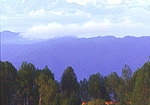


| 
| ||
| HOME | TRAVEL | TRAVELOG | |||

Cloud Nine ...a weekend in Ranikhet Sanjay Singh Badnor
My association with Ranikhet began a long time ago. As far back as I can remember, I would longingly gaze at the white framed canvas, painted by the now octogenarian Bengali artist B C Gue, which hung on the wall of my family home at Ajmer in Rajasthan. It was simply titled Sunset Ranikhet. Sitting at the Cost Plus resort, about 10 km further up from Ranikhet, at Majhkali, I was astonished to be reliving that very familiar painting.
On a Thursday night, we boarded an overnight AC bus from Kashmere Gate, Old Delhi, and reached Nainital at 0700 hours, in pouring rain. It seemed futile to hang around, so we decided to catch the first bus to Ranikhet. As luck would have it, we caught a local passenger bus which stopped at every little village and hamlet to take passengers on. The bus was in a sorry state, but since there was plenty of space, initially, we were happy to stretch our weary legs. Our pleasure was short lived. Shortly thereafter, the bus was spilling over with people, postal gunny bags (the bus also doubled as a postal van), vegetable baskets and who knows what else. The simple village folk were oblivious to the chaos and lack of space. They were rather amused to see two city brats, with fancy totes and Walkmans, feeling quite out of place in this typically rural atmosphere.
About midway between Nainital and Ranikhet, the weather seemed to look a bit more optimistic, which immediately enthused me. I tried to nudge my drowsy friend awake, so that he too could admire the pristine scenery trying to peep its way through the clouds. A few minutes later, thick gray clouds enveloped us again. It began to rain, and rained all the way till Ranikhet. After disembarking from the rickety claptrap that had brought us this far, we meandered through the streets, filled with vividly coloured umbrellas, to the local jeep stand to catch a ride to Majhkali, 10 km beyond Ranikhet.
Almost as if to prove him wrong, a little while later the weather cleared. From the hotel's terrace restaurant (aptly named Cloud 9), that evening, we were treated to a panoramic view of the Kumaon Himalayas, stretching endlessly from one end to the other. An uninterrupted view of 200 miles of snow clad peaks, swathed in a brilliant glow. Magnificent. One could distinctly spot Nanda Devi (25,645 ft), Nanda Ghoti (21,286 ft), Trishul, Panchkoti and the Panchachuli peaks. Nature was putting up a grand show.
Unlike most Indian hill stations, Ranikhet – thankfully -- does not boast of a conventional mall. Malls attract hordes of tourists. Ranikhet therefore affords no 'official' tourist sights. Aadesh, the resort's owner, suggested some day excursions. We set off for the day with Sher Singh Bisht, our Kumaoni driver and guide. The first halt was at Kalika village, famous for its Kali temple, situated on a hill. Photography was not permitted. I dearly wish I could have taken a few snaps of the women sadhus, who were chilling out, smoking chillums.
A little ahead we encountered another interesting signboard that read -- Halt, look and proceed, leopards have right of way. We passed the quaint hamlets of Tarikhet and Soni enroute, before entering the thick pine forest. We were forced to abandon the car and walk down the winding pathway to the Binsar Mahadev temple. It was built aside a babbling stream, and was wonderfully serene and peaceful, devoid of any tourists. I spotted a pair of birds of paradise engaged in a courtship dance.
| |
SHOPPING HOME | BOOK SHOP | MUSIC SHOP | HOTEL RESERVATIONS PERSONAL HOMEPAGES | FREE EMAIL | FEEDBACK |